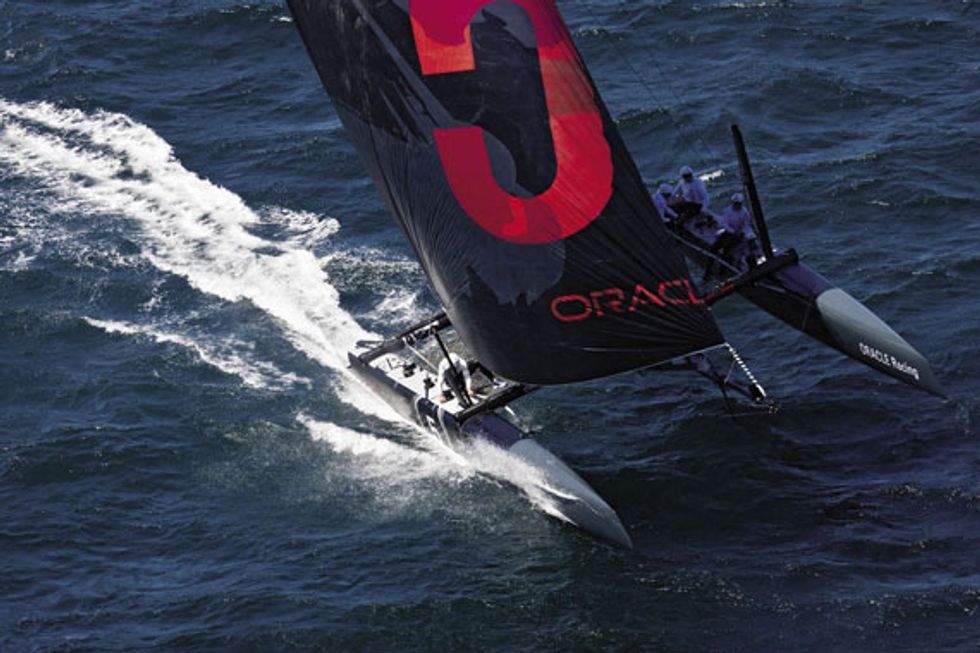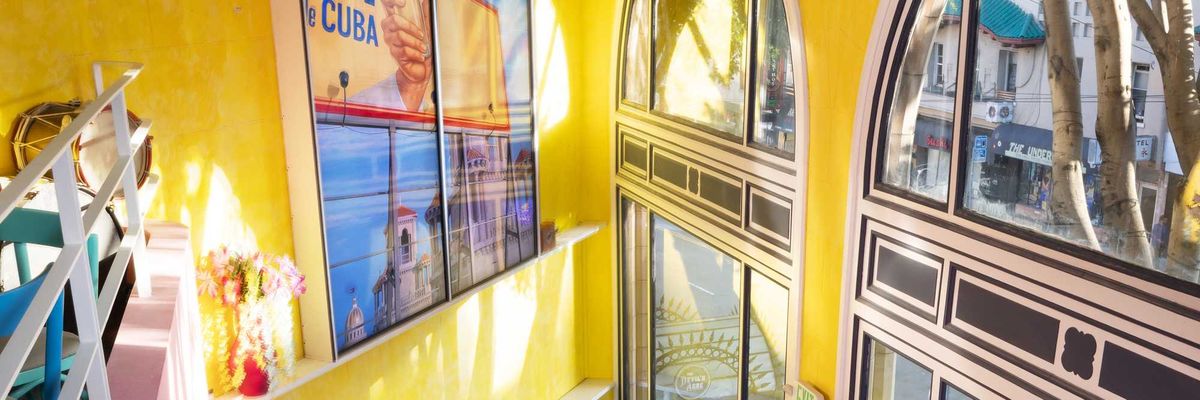A stiff afternoon breeze tousles Tom Ehman’s light, dapper hair as he strolls from a chauffeured car to the water’s edge at the Marina Green. Whitecaps bristle as a swift current gushes east toward Alcatraz. This same famous stretch of san francisco’s windblown waterfront will be transformed this summer and next into a racetrack for some of the most exciting sailing the world has ever seen—the 34th America’s Cup, held on the home turf of defending champion and Oracle CEO Larry Ellison.
Ehman, 58, is a veteran organizer of America’s Cup regattas and vice commodore of the Golden Gate Yacht Club—which sponsors Ellison’s Oracle Team USA since efforts to partner with the ritzier St. Francis Yacht Club were stalled and eventually rebuffed in the year 2000, well before the crew won the cup in 2010. Ehman wears a tiny silver replica of the famous cup, proudly pinned to his blue blazer, and points to the Golden Gate Bridge.“The races will start over by the bridge,” he says, his eyes tracking the near-shore path of the racecourse that will extend from the iconic landmark and beyond Fort Mason to the east. “You’re going to feel like you can reach out and touch it.” While the average spectator may not be able to touch it, the races’ proximity to SF shores, as well as a live TV broadcast, guarantee local aficionados and lookiloos an up-close view of the action.
Scheduled for Aug. 21 through 26 and during Fleet Week in October, this year’s 45-foot catamaran races are part of the America’s Cup World Series, a new tournament created by Ellison that promises to be a competitive and colorful prelude to America’s Cup racing (scheduled for next year along the same course for 72-foot catamarans). World Series regattas, which began in August 2011, have pitted nine or so teams against each other in sailing hotspots around the world—previous races were held in Portugal, Italy, and San Diego. But the SF races allow sailors a unique opportunity to practice in the bay’s squally aquatic arena. The preliminary racing also provides event organizers with a dress rehearsal for the pomp and hubbub expected during America’s Cup racing next year.
But most of all, the regattas are an experiment and a gamble. Ellison is betting that the new format—to be broadcast live using the same Emmy award-winning technology that draws on-screen down lines for football audiences—will woo a younger generation of fans to his fancy pastime that’s becoming something of an extreme sport. Crashes are a common and exciting feature of World Series racing: Ellison’s own Oracle team famously flipped and damaged one of its boats while training on the bay in 2011.
Paul Cayard, a six-time America’s Cup yachtsman from Twin Peaks, says he’s “always believed the San Francisco Bay would be a great stadium for a major sailing event. It’s known to be one of the windiest venues in the world.” Swift westerly currents barging headfirst into the easterly wind foster choppy conditions in the bay. That wind means tough terrain for America’s Cup athletes. Rough waters take heavy tolls on the elite sailors competing in these catamarans, which can easily flip over if a bow is stubbed into an oncoming swell. “The 17-year-old who’s into snowboarding will look at it and say, ‘Wow, that’s pretty cool,’” says Cayard, who now leads the Swedish Artemis Racing team as its chief executive.
The races meld the traditions and skills of sailing with the crashes, capsizes, and extreme close-shore racing that make it a true white-knuckle sport. John Kostecki, a Team Oracle tactician who, at age 48, is among the event’s oldest competitors, says the boats “are quite physical and very demanding. You need to be on top of your game.” From San Rafael, Kostecki is another rare Bay Area native in the series. Most of the sailors are from Australia, New Zealand, or Europe.
Born from a yacht race that coincided with the 1851 World’s Fair in London, the America’s Cup has a storied history. That year, Queen Victoria commissioned its ultimate prize, the coveted sterling silver trophy known as the Auld Mug. Crafted by Crown Jewelers Gerrard & Co., the cup was first clinched by the New York Yacht Club during a race against British crews, held between the Isle of Wright and mainland England. The champions defended the cup successfully throughout the 19th century until 1983. That year, a crew representing Australia outpaced the long-reigning champions with a cunning keel design.
Thanks in part to the Aussies’ winning innovation, the tournament became increasingly elite. Progressively larger and more advanced boats were needed to win, and only a handful of the world’s richest people could afford them. Since the early ’80s, the cup has changed hands between teams representing New Zealand, Switzerland, and, in 2010, the United States’ own Golden Gate Yacht Club (scored off the coast of Spain). As the winner, Ellison and his team vowed to replace elitist yachting with a more modern sport crafted for shoreline spectators and television audiences.
Under sea change rules introduced by Ellison, the 45-foot and 72-foot catamarans built by competing teams must conform to basic specifications in order to constrain costs, level the playing field, and encourage more teams to take part. Live broadcast is also returning this year. For each week of sailing this August and October, NBC will air the final day, sending the America’s Cup World Series into bars and homes around the nation. Recently adapted for sailing races, LiveLine broadcast technology will track the catamarans with cameras mounted to helicopters. Oversized TV screens and stadium seating are planned along the racecourse, and organizers are set to offer some free public seating this year.
Views to the races will not only be free to locals and visitors, they may also be unobstructed. Due to the sport’s long-waning popularity and the current state of the economy, crowd projections have tumbled from the initial estimated draw of more than a half-million spectators. Still, organizers say that internationally telecast World Series events have been successful in igniting public interest for the sport.
The results of the World Series have no bearing on the 2013 America’s Cup, which will be preceded next summer by one-on-one matches among many of the teams that will race larger catamarans along this same course in pursuit of the Louis Vuitton Cup. The winner of the LV Cup will become the America’s Cup challenger and go head-to-head with Ellison’s team in a best-of-nine series in September 2013. That winner will not just take home the ultimate prize in sailing. The champion will also decide where and when to race the next regatta and whether to keep or abandon the changes adopted by Ellison.
This year’s races and the 2013 America’s Cup will not only put a new format of sailing to the test. The event will also measure the Bay Area’s appetite for an international sailing spectacle. If Ellison’s team takes home the Auld Mug again next year, many expect that he will choose to bring the event back to San Francisco—where he’s made his home and fortune—again within the next several years.
Ehman warns, however, that the winds of change could blow future America’s Cup regattas away from the bay. “If somebody else has a better venue and they want to support it financially, and if this town is just ho-hum [about it], then you have to rethink it,” he says. “But this venue is going to be so cool, and the sailing so good, that I think we could end up doing it here again.”
This article was published in 7x7's July/August issue. Click here to subscribe.























